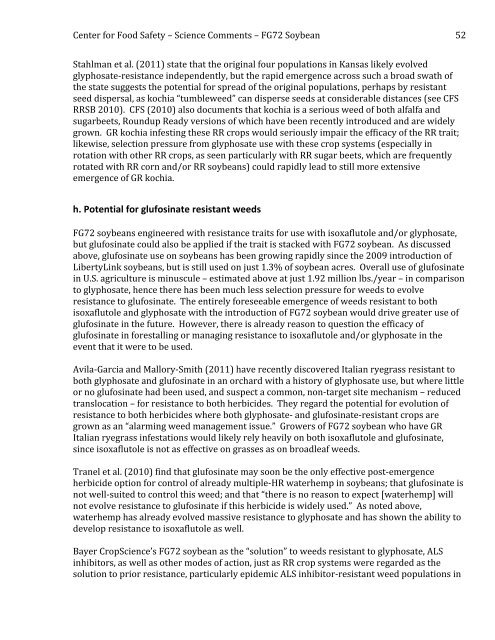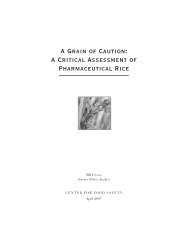a four-fold rise - Center for Food Safety
a four-fold rise - Center for Food Safety
a four-fold rise - Center for Food Safety
You also want an ePaper? Increase the reach of your titles
YUMPU automatically turns print PDFs into web optimized ePapers that Google loves.
<strong>Center</strong> <strong>for</strong> <strong>Food</strong> <strong>Safety</strong> – Science Comments – FG72 Soybean <br />
52 <br />
Stahlman et al. (2011) state that the original <strong>four</strong> populations in Kansas likely evolved <br />
glyphosate-‐resistance independently, but the rapid emergence across such a broad swath of <br />
the state suggests the potential <strong>for</strong> spread of the original populations, perhaps by resistant <br />
seed dispersal, as kochia “tumbleweed” can disperse seeds at considerable distances (see CFS <br />
RRSB 2010). CFS (2010) also documents that kochia is a serious weed of both alfalfa and <br />
sugarbeets, Roundup Ready versions of which have been recently introduced and are widely <br />
grown. GR kochia infesting these RR crops would seriously impair the efficacy of the RR trait; <br />
likewise, selection pressure from glyphosate use with these crop systems (especially in <br />
rotation with other RR crops, as seen particularly with RR sugar beets, which are frequently <br />
rotated with RR corn and/or RR soybeans) could rapidly lead to still more extensive <br />
emergence of GR kochia. <br />
h. Potential <strong>for</strong> glufosinate resistant weeds <br />
FG72 soybeans engineered with resistance traits <strong>for</strong> use with isoxaflutole and/or glyphosate, <br />
but glufosinate could also be applied if the trait is stacked with FG72 soybean. As discussed <br />
above, glufosinate use on soybeans has been growing rapidly since the 2009 introduction of <br />
LibertyLink soybeans, but is still used on just 1.3% of soybean acres. Overall use of glufosinate <br />
in U.S. agriculture is minuscule – estimated above at just 1.92 million lbs./year – in comparison <br />
to glyphosate, hence there has been much less selection pressure <strong>for</strong> weeds to evolve <br />
resistance to glufosinate. The entirely <strong>for</strong>eseeable emergence of weeds resistant to both <br />
isoxaflutole and glyphosate with the introduction of FG72 soybean would drive greater use of <br />
glufosinate in the future. However, there is already reason to question the efficacy of <br />
glufosinate in <strong>for</strong>estalling or managing resistance to isoxaflutole and/or glyphosate in the <br />
event that it were to be used. <br />
Avila-‐Garcia and Mallory-‐Smith (2011) have recently discovered Italian ryegrass resistant to <br />
both glyphosate and glufosinate in an orchard with a history of glyphosate use, but where little <br />
or no glufosinate had been used, and suspect a common, non-‐target site mechanism – reduced <br />
translocation – <strong>for</strong> resistance to both herbicides. They regard the potential <strong>for</strong> evolution of <br />
resistance to both herbicides where both glyphosate-‐ and glufosinate-‐resistant crops are <br />
grown as an “alarming weed management issue.” Growers of FG72 soybean who have GR <br />
Italian ryegrass infestations would likely rely heavily on both isoxaflutole and glufosinate, <br />
since isoxaflutole is not as effective on grasses as on broadleaf weeds. <br />
Tranel et al. (2010) find that glufosinate may soon be the only effective post-‐emergence <br />
herbicide option <strong>for</strong> control of already multiple-‐HR waterhemp in soybeans; that glufosinate is <br />
not well-‐suited to control this weed; and that “there is no reason to expect [waterhemp] will <br />
not evolve resistance to glufosinate if this herbicide is widely used.” As noted above, <br />
waterhemp has already evolved massive resistance to glyphosate and has shown the ability to <br />
develop resistance to isoxaflutole as well. <br />
Bayer CropScience’s FG72 soybean as the “solution” to weeds resistant to glyphosate, ALS <br />
inhibitors, as well as other modes of action, just as RR crop systems were regarded as the <br />
solution to prior resistance, particularly epidemic ALS inhibitor-‐resistant weed populations in







